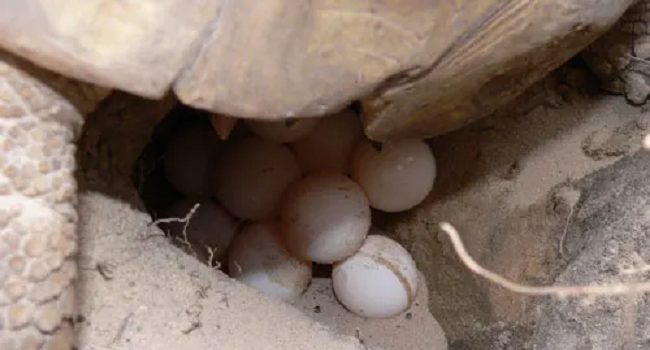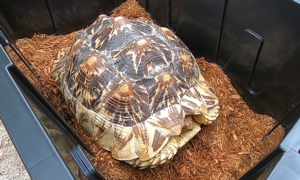If you have multiple sulcatas, it’s important to know if you have male or female tortoises. Sulcata tortoises can breed as young as five years old, although it is best to wait until the female is larger and older. Breeding can be very stressful for the female tortoise. Not only does she have to undergo the sometimes forceful and aggressive mating from the male tortoise, but she has to grow up to 20 eggs per clutch. And females will lay up to five or six clutches a year!
If you’re going to raise multiple sulcata tortoises together or if you’re intending on breeding, it’s important to know how long sulcata tortoises are pregnant and what to look for.
Mating Sulcata Tortoises
A male will try to mate with a female around February or after a rainy season. But, there is no set breeding season for sulcatas. The female will gestate for about 60 days before she starts nesting. She may test several nests before she finds the perfect spot. It will take about 1 to 4 hours to complete the nest, and then she’ll lay one egg every three minutes, or so.
It will take about 90 – 120 days for the eggs to incubate. You may need one or more good incubators to be able to incubate all of the eggs.
Is My Sulcata Tortoise Pregnant?
Once a male and female tortoise mates, a female can store viable sperm for up to three years! That does not necessarily mean that for up to three years you are guaranteed viable eggs, but it means there’s a possibility.
Pregnant female sulcata tortoises won’t have a noticeable baby bump, but you may notice a few differences in your tortoise.
- Increased aggression typically toward other female tortoises but sometimes humans
- Increases agitation
- Increased crankiness
- Increased protectiveness over her space. Try separating her from other tortoises
- Pregnant females will tend to dig more and test out nesting spots throughout the habitat.
- She may nudge the ground with her nose to test for soft soil and moisture levels.
- She may start slowing her eating.
Palpate A Female Tortoise
You can check your female tortoise for eggs.
- Lift the tortoise.
- Hold her back legs out of the way.
- With gentle pressure, insert a finger inside the abdomen. If she’s soft and squishy, she’s probably not pregnant. If you feel something firm, it’s an egg.
Don’t do this regularly or often. Palpating a female tortoise can be very stressful for the tortoise.
Warning Signs to Watch For With a Pregnant Female Tortoise
If you have a pregnant sulcata tortoise, you want to pay attention to certain signs that could indicate problems.
- Difficulty in breathing
- Edema
- Head swelling
- Lack of appetite
- Red, swollen eyes
- Runny nose
- Shell problems
- Spots on the skin
- Weight loss
If you notice any of these signs, contact your reptile vet. When pregnant, some of these more subtle signs could be more dangerous than they normally would.





